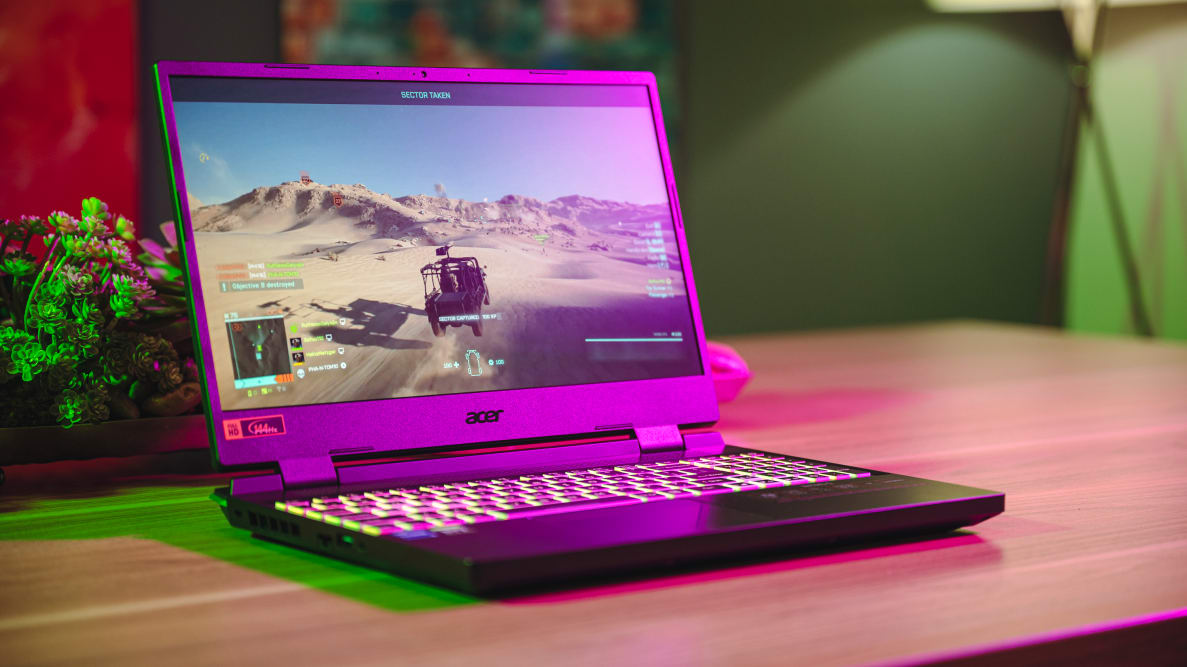Pros
-
Great 1080p performance
-
Quality keyboard and trackpad
-
Chassis stays cool
Cons
-
Mediocre battery life
-
Muted display, mediocre audio
-
Chunky chassis
About the Acer Nitro 5
Here are the specs of the gaming laptop we tested:
-
Processor: Intel Core i5-12500H
-
Graphics: Nvidia RTX 3060
- RAM: 16GB DDR4 SDRAM
-
Storage: 512GB
-
Display: 1920 x 1080p @ 144Hz display
- Ports: 1 x HDMI; 1 x USB-C; 4 x USB-A; 1 x Ethernet; 1 x Headphone jack
-
Wireless connectivity: Wi-Fi 6, Bluetooth 5.2
-
Webcam: 720p
-
Battery: 230 W battery charger
-
Weight: 5.51 pounds
-
Size: 14.2 x 10.7 x 1.1 inches
-
Warranty: 1-year limited warranty
Depending on the configuration, the Nitro 5 can cost anywhere between $780 to $2,300. The base configuration has an 11th-gen Intel Core i5 processor, an Nvidia GTX 1650 graphics card, 8GB of memory, and 256GB of storage, while the top configuration has a 12th-gen Intel Core i7 processor, an Nvidia RTX 3070Ti graphics card, a 2560 x 1440p display, 32GB of memory, and 2TB of storage. Our configuration cost $1,299 at the time of testing.
What we like
The new look is as cool as the chassis temps
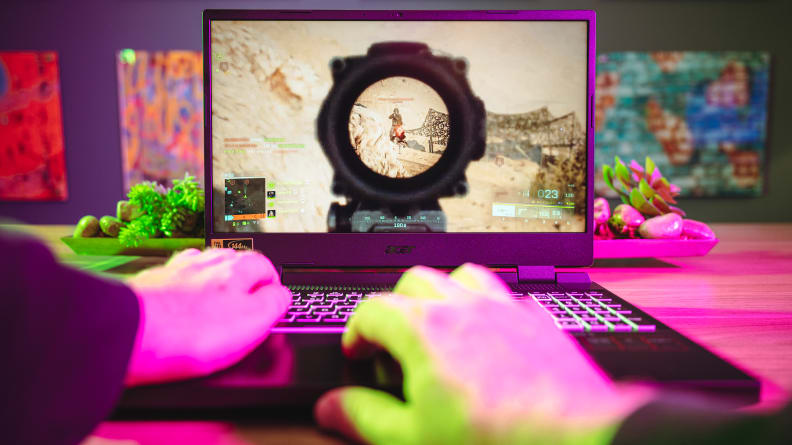
The new Nitro 5 ditches the bright red details, instead trading it for a pearly black finish with subtle teal and maroon lines.
The older Nitro 5’s black-and-red aesthetic was starting to feel dated, so I’m thrilled to see this new all-black scheme with subtle colored highlights replace it. It’s just as bulky as before, but that bulk gives the hardware enough room to breathe and keep cool even when running graphically demanding games.
When I ran Shadow of the Tomb Raider for about a half-hour, the bottom of the laptop averaged around 35 degrees Celsius (95 Fahrenheit), and didn’t feel uncomfortable on my lap Internally, the hardware also stays cool. The graphics card didn’t go past 70 C (158 F), and the processor remained under 90 C (194 F) most of the time. Both of those temperature readings mean the components’ thermals are well within spec.
The fans weren’t loud when playing games, either. Even for strenuous games like Cyberpunk 2077, the fans weren’t loud enough to make dialogue or louder game sound effects inaudible.
Comfortable keyboard and trackpad
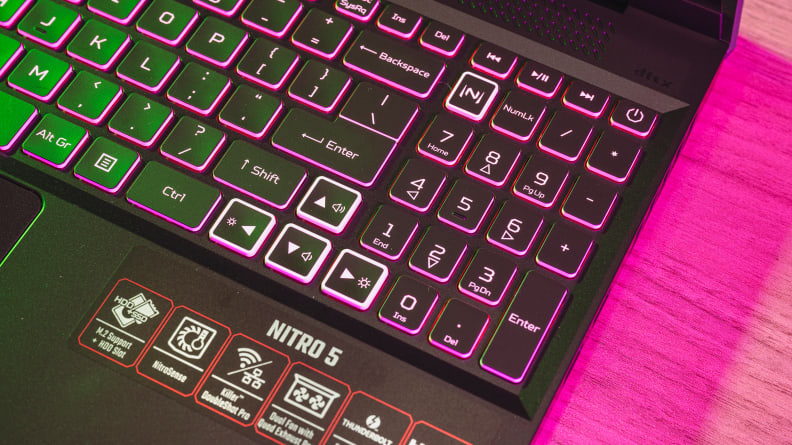
Even without the backlight, the keyboard is easy to read in dark spaces.
If you like your keyboards big and built for quick typists, you’ll like the Nitro 5’s keyboard. Not only are the keys themselves a little bigger than your average laptop key, but they’re also more spaced apart than usual. The keys have a lot of depth and depress with the perfect amount of force—easy on the fingers, but not so delicate that I’m accidentally pressing keys.
On the right, the keyboard has a dedicated Numpad and three media keys. The WASD keys have a different font than the other keys, and the knobs on the F and J keys are prominent. The red backlight complements the white lining of the keys, making it easy to type in the dark.
Meanwhile, the trackpad is huge, smooth, and responsive, making it easy to navigate across the screen. Multi-touch gestures consistently register, and the fairly smooth surface provides little friction. Clicking is also accurate, although it requires some force to actuate.
If you’d rather use an external mouse and keyboard, the laptop also has a lot of USB ports to plug in peripherals, as well as an HDMI port and an Ethernet port.
Perfect gaming performance
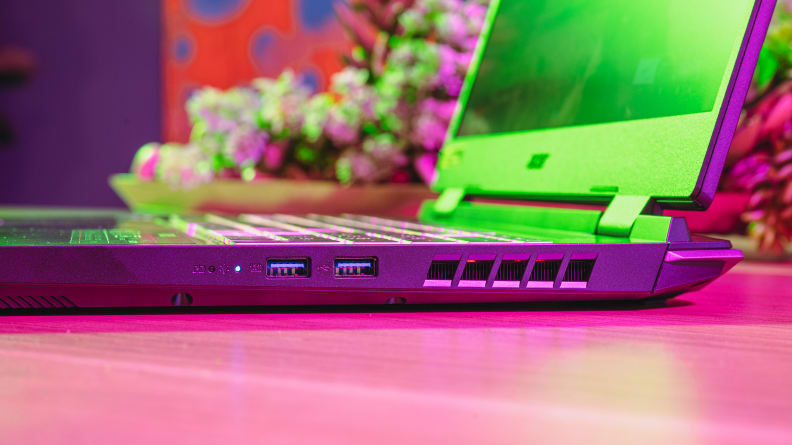
The RTX 3060 graphics card gives it the power to play many 1080p games at 120 fps or more.
Whether you’re an e-sports gamer or an RPG enthusiast, the Nitro 5 can keep up. I was able to run Shadow of the Tomb Raider set to its highest 1080p graphics setting at 92 frames per second, which looked buttery smooth on the Nitro 5’s 144Hz display. That’s right on target for both the hardware and the price range of this laptop.
For instance, the HP Victus 16, is a similarly priced laptop with an 11th-gen Intel Core i7 and the same RTX 3060 graphics card as the Nitro 5 that pushed 90 fps in the same game. The newer 12th gen Intel Core processors are so powerful because of their hybrid core design, which allows the processor to use its cores more efficiently than those running on last-gen architecture. This lets the lower-tier Core processors, like the Nitro 5’s 12th-gen Core i5, run programs as quickly as the higher-tier chips of the last generation—all while keeping the power consumption lower than last-gen, too.
For gaming, whether you’re running an 11th-gen Core i7 or a 12th-gen Core i5 won’t make a notable difference (most games’ performance is GPU-bound) but the 12th-gen architecture is a boon for multithreaded processes like 3D modeling and rendering. The Nitro 5’s processor rendered a car model in Blender in three minutes and four seconds while the HP Victus 16’s processor rendered it in four minutes five seconds, for instance.
But if you’re debating between this new Nitro 5 and last-gen's model we reviewed with an entry-level Nvidia GTX 1650 graphics card, go with the new model. It’s a massive price difference ($730 versus $1,299, respectively, at the time of writing) but the performance jump is significant. The GTX 1650 can only reach 45 fps in Shadow of The Tomb Raider at the same settings—half of the Nvidia RTX 3060 version’s framerate. Its CPU performance also gets a boost, with the new Nitro 5’s Intel Core i5-12500H trouncing the old one’s Ryzen 5 4600H in Cinebench, where the Intel Core i5 scored 13221 points, almost 60% more points than the Ryzen 5.
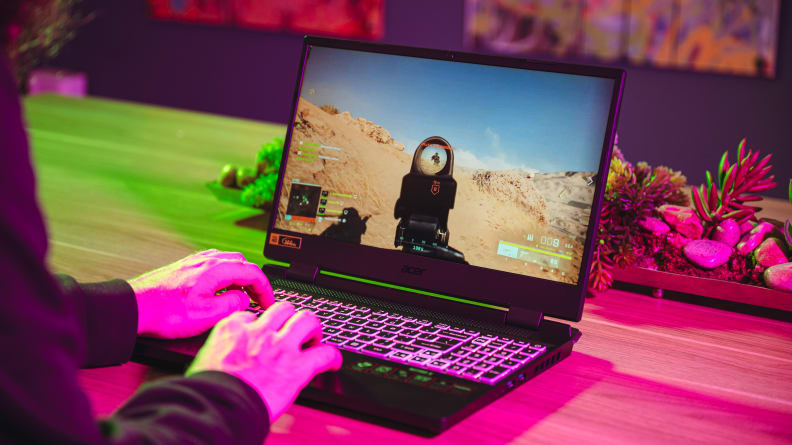
The Nitro 5 is, in many ways, the archetypal gaming laptop: a large chassis to keep components cool, performance-forward, and a keyboard optimized for gaming.
The RTX 3060 Nitro 5 also offers ray tracing—which is missing on the GTX 1650 model—and if the game isn’t graphically taxing you should be able to net at least 60 fps at 1080p with the graphics set to a detailed preset, like High or Ultra. (Minecraft is a great example.) However, a game like Cyberpunk 2077 can be too much for the RTX 3060. When we tested the game on 1080p Ultra without ray tracing on the Nitro 5, we scratched 62 fps, and enabling ray tracing knocked the framerate down to 46 fps. You’ll need to lower the graphics preset or enable Nvidia DLSS to get anything higher.
But it’s not all bad news. In fact, the Nitro 5 is better at ray tracing than some pricier gaming laptops with an AMD graphics card. The Asus ROG Strix G15 AMD Advantage, which has a comparable Radeon RX 6800M graphics card, scored 80 fps on normal 1080p Ultra, but just 21 fps on 1080 Ultra with ray tracing.
For less strenuous games, the Nitro 5 can really take advantage of its display’s 144Hz refresh rate. On the highest 1080p graphics settings possible for each game, Total War: Warhammer II ran at 100 fps, Final Fantasy XIV ran at 85 fps (in a crowded plaza), and Overwatch ran at 125 fps.
When it comes to central processing power, the Nitro 5’s Intel Core i5-12500H competes with higher-end processors from AMD and previous Intel generations. In synthetic benchmarks, the Nitro 5 scored 13221 points in Cinebench and 8767 points in Geekbench 5’s multi-core benchmark, which is higher than the HP Victus’s Intel Core i7-11800H (10306 and 9400, respectively), and the Asus ROG Strix G15’s AMD Ryzen 9-5900HX (13332 and 7715, respectively.)
Both the Victus’s and ROG Strix G15’s processors are some of the best mobile CPUs available, which makes it more incredible that Intel’s latest mid-range processor can compete.
What we don’t like
Awful battery life
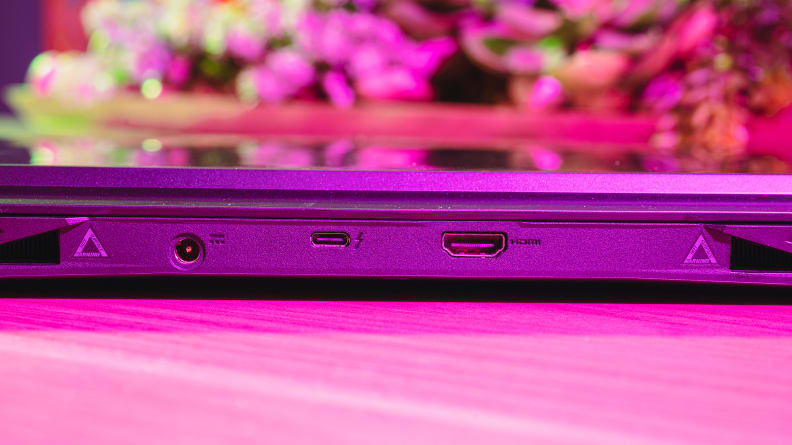
With less than four hours of battery life, you can hardly take this on the go.
A gaming laptop is still a laptop, and it should be able to handle common productivity tasks without draining the battery quickly. To test battery life, we let laptops cycle through web pages with the screen set to 200 nits of brightness, which is a good approximation of someone who’s using a laptop to edit docs in Google Drive and watch a couple of episodes of a show on Netflix while they’re away from home.
Sadly, this Acer Nitro 5 could not make it to four hours—it lasted three hours and 40 minutes before going kaput. Such a short life makes it hard to tote the Nitro 5 around a classroom or office without planting your chair next to a power outlet. It’s not the worst we’ve seen among gaming laptops by any means (quite a few still struggle to pass the three-hour mark), but it’s disappointing to see no progress since last gen’s Nitro 5, especially when there are many other gaming laptops on the market that have six or more hours of battery life.
The old Nitro 5 with an Nvidia GTX 1650 graphics card managed around six hours. The Asus ROG Zephyrus G14 hit eight hours 44 minutes in our testing. The HP Victus 16 lasted for seven hours 35 minutes, and the Lenovo Legion 5 Pro lasted for six hours. (MSI’s Delta 15 gaming laptop lasted a whopping nine hours and 40 minutes!) It’s unfortunate to see this new Nitro 5 marred by such short battery life.
Washed-out display, mediocre audio
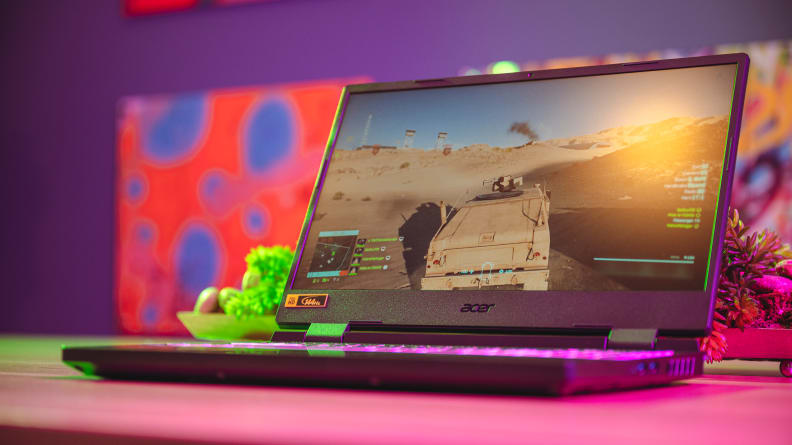
While it's nice to have 144Hz refresh rate, it's offset by the laptop's mediocre color gamut.
If you want to play games with a breathtaking visual experience, the Nitro 5 isn’t for you. While the display’s 144Hz refresh rate creates buttery smooth motion in games, the washed-out colors won’t make the action pop.
When I measured the display’s color output and brightness with a colorimeter, the Nitro 5 could only reproduce about 60% of the standard RGB color gamut. That means any game you play on the laptop is going to look dull, and in an age where a lot of gaming laptops have phenomenal screens that at least cover the entire sRGB gamut, that’s disappointing.
The Nitro 5’s screen isn’t particularly bright, either. At 282 nits of max brightness, the display is bright enough for a well-lit indoor space, but it may look dark in sunlight. On the other hand, it does have good black levels, so if you stick to the great indoors, the Nitro 5’s high display contrast gives a lot of depth to visual content.
Moving on to the audio—while the sound is not crackly or distorted, it’s quiet even at max volume, and its lower mids are recessed to the point that the audio can sound hollow. It’ll do for the quick YouTube video, but if you want to play a game with a lot of audio cues, you will want to connect a gaming headset or computer speakers for a better sound stage and more depth.
Enough with the bloatware!
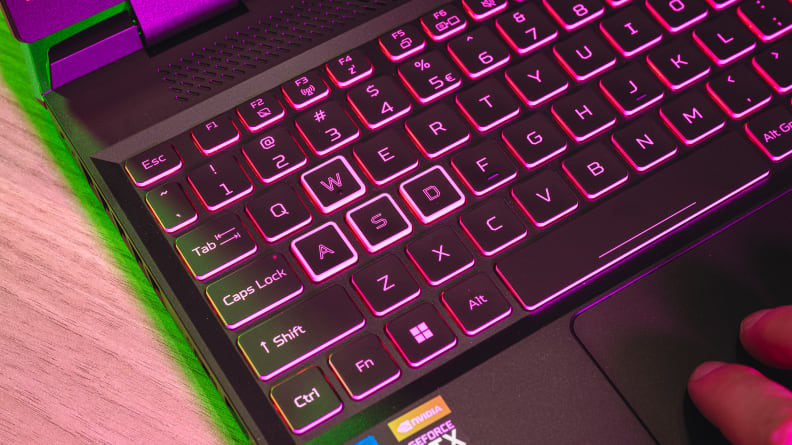
The WASD keys have a strong outline to make them easier to find. However, you won't be using WASD if you're too busy clicking out of bloatware pop-ups.
Out of the box, the Nitro 5 comes loaded with a bunch of unnecessary software. Some of it may be the software you’d end up downloading anyway, like Dropbox, but a lot of it is bloatware that at best are marginally useful tools and at worst tank processor performance.
NitroSense is the most useful, as it offers a platform to monitor fan RPM and processor temps, change keyboard lighting, change audio EQ presets, and mess with performance modes. However, Norton Security antivirus software slowed down our PC’s performance until we removed it, and Acer Care Center continually spammed the notifications center. All of these programs are thankfully easy to remove in the Windows Add/Remove Programs menu.
Should you buy the Acer Nitro 5?
Yes, it has more perks than quirks
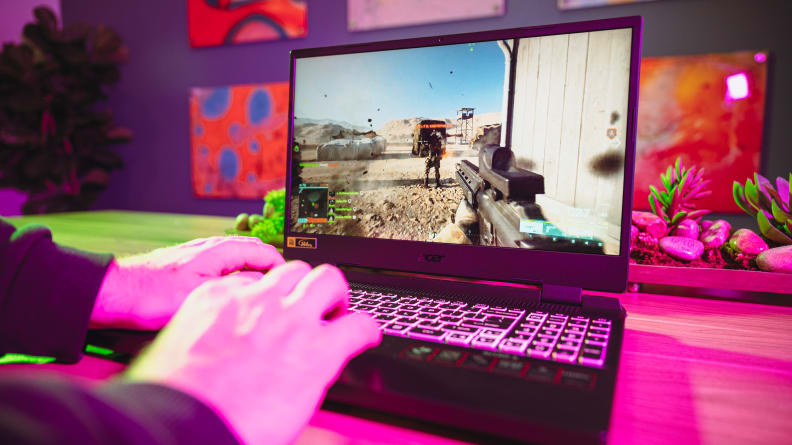
If gaming's most of what you do on a PC, the Nitro 5 is a great match for you.
The Nitro 5 is a laptop built first and foremost for gamers. Its high-refresh display, powerful graphics card, and hefty chassis give it the performance necessary to run games like Shadow of the Tomb Raider at high framerates without a hitch. While the loaded configuration we tested is a little costly at $1,299, it's well worth the price.
However, if you’re looking for a laptop that is good for more than gaming, you could feel trapped by the Nitro 5’s bulky design and short battery life, which severely limit its portability. You can snag the Asus ROG Strix G15 AMD Advantage Edition for the same price as the Nitro 5 or less on sale, and it outperforms the Nitro 5 for non-ray tracing gaming. It also sports a notably thinner chassis and has nine hours of battery life, but you’d still be getting a mediocre display.
If you want a gaming laptop with a great display that won’t break the bank, the HP Victus 16, a laptop with a beautiful metal chassis and a vivid display, offers a similar configuration for almost the same price as the Nitro 5. If you’re willing to spend a couple of hundred dollars more, the Asus ROG Zephyrus G14 crushes the Nitro 5 in performance, includes an HDR-ready display, and has eight hours of battery life. Ultimately, if you find yourself choosing between the Nitro 5, Asus ROG Strix G15, and the HP Victus 16, the best option among the three will be the one that’s on sale at the time.
While the $1,299 Nitro 5 does not stand out among the crowd like the cheaper, last-gen Nitro 5, it still offers a good package for the price. Unless you need a laptop to carry around all the time, you’ll find a lot to like in this reliable gaming laptop.
The product experts at Reviewed have all your shopping needs covered. Follow Reviewed on Facebook, Twitter, Instagram, TikTok, or Flipboard for the latest deals, product reviews, and more.
Prices were accurate at the time this article was published but may change over time.
Meet the tester
Adrien has over 4 years of experience covering laptops, desktops, software, games, and more.
Checking our work.
Our team is here to help you buy the best stuff and love what you own. Our writers, editors, and experts obsess over the products we cover to make sure you're confident and satisfied. Have a different opinion about something we recommend? Email us and we'll compare notes.
Shoot us an email
